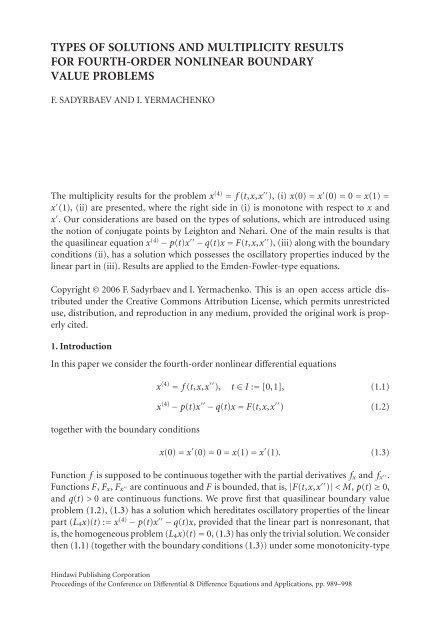DIFFERENtIAl & DIFFERENCE EqUAtIONS ANd APPlICAtIONS
DIFFERENtIAl & DIFFERENCE EqUAtIONS ANd APPlICAtIONS
DIFFERENtIAl & DIFFERENCE EqUAtIONS ANd APPlICAtIONS
You also want an ePaper? Increase the reach of your titles
YUMPU automatically turns print PDFs into web optimized ePapers that Google loves.
TYPES OF SOLUTIONS AND MULTIPLICITY RESULTS<br />
FOR FOURTH-ORDER NONLINEAR BOUNDARY<br />
VALUE PROBLEMS<br />
F. SADYRBAEV AND I. YERMACHENKO<br />
The multiplicity results for the problem x (4) = f (t,x,x ′′ ), (i) x(0) = x ′ (0) = 0 = x(1) =<br />
x ′ (1), (ii) are presented, where the right side in (i) is monotone with respect to x and<br />
x ′ . Our considerations are based on the types of solutions, which are introduced using<br />
the notion of conjugate points by Leighton and Nehari. One of the main results is that<br />
the quasilinear equation x (4) − p(t)x ′′ − q(t)x = F(t,x,x ′′ ), (iii) along with the boundary<br />
conditions (ii), has a solution which possesses the oscillatory properties induced by the<br />
linear part in (iii). Results are applied to the Emden-Fowler-type equations.<br />
Copyright © 2006 F. Sadyrbaev and I. Yermachenko. This is an open access article distributed<br />
under the Creative Commons Attribution License, which permits unrestricted<br />
use, distribution, and reproduction in any medium, provided the original work is properly<br />
cited.<br />
1. Introduction<br />
In this paper we consider the fourth-order nonlinear differential equations<br />
together with the boundary conditions<br />
x (4) = f (t,x,x ′′ ), t ∈ I := [0,1], (1.1)<br />
x (4) − p(t)x ′′ − q(t)x = F(t,x,x ′′ ) (1.2)<br />
x(0) = x ′ (0) = 0 = x(1) = x ′ (1). (1.3)<br />
Function f is supposed to be continuous together with the partial derivatives f x and f x<br />
′′.<br />
Functions F, F x , F x<br />
′′ are continuous and F is bounded, that is, |F(t,x,x ′′ )| 0 are continuous functions. We prove first that quasilinear boundary value<br />
problem (1.2), (1.3) has a solution which hereditates oscillatory properties of the linear<br />
part (L 4 x)(t):= x (4) − p(t)x ′′ − q(t)x, provided that the linear part is nonresonant, that<br />
is, the homogeneous problem (L 4 x)(t) = 0, (1.3) has only the trivial solution. We consider<br />
then (1.1) (together with the boundary conditions (1.3)) under some monotonicity-type<br />
Hindawi Publishing Corporation<br />
Proceedings of the Conference on Differential & Difference Equations and Applications, pp. 989–998

















